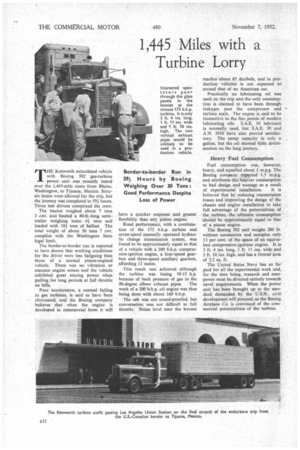1,445 Miles with a Turbine Lorry
Page 50

If you've noticed an error in this article please click here to report it so we can fix it.
Border-to-border ,Run in 591 Hours by Boeing Weighing Over 30 Tons: Good Performance Despite
Loss of Power
pi, HE Kenworth articulated vehicle with Boeing 502 gas-turbine power unit was .recently tested over the 1,445-mile route from Blaine, Washington, to Tijuana, Mexico. Sixtysix hours were allowed for the trip, but the journey was completed in 591 hours. Three test drivers comprised the crew.
The tractor weighed about 7 tons 3 cwt. and hauled a 40-ft-long semitrailer weighing some 4/ tons and loaded with 181 tons of ballast. The total weight of about 30 tons 7 cwt. complies with the Washington State legal limit.
The border-to-border run is reported to have shown that working conditions for the driver were less fatiguing than those of a normal piston-engined vehicle. There was no vibration or staccato engine noises and the vehicle exhibited great staying power when pulling for long periods at full throttle on hills.
Poor acceleration, a normal failing in gas turbines, is said to have been eliminated, and the Boeing company believes that when the engine is• developed in commercial form it will
have a quicker response and greater flexibility than any piston engine.
Road performance, with a combination of the 175 b.h.p. turbine and seven-speed manually operated hydraulic change transmission system, was found to be approximately equal to that of a vehicle with a 200 bl.p. compression-ignition engine, a four-speed gear-box and three-speed auxiliary gearbox, affording 12 ratios.
This result was achieved although the turbine was losing 10-15 h.p. because of back pressure of gas in the 90-degree elbow exhaust pipes. The work of a 200 b.h.p. oil engine was thus being done with about 160 b.hp.
The cab was not sound-proofed, but conversation was not difficult at full throttle. Noise level near the bonnet reaches about 85 decibels, and in production vehicles is not expected to exceed that of an American car.
Practically no lubricating oil was used on the trip and the only consumption is claimed to have been through leakages past the compressor and turbine seals. The engine is said to be insensitive to the fine points of modern lubricating oils. S.A.E. 10 lubricant is normally used, but S.A.E. 30 and A.N. 1010 have also proved satisfactory. The sump capacity is only a gallon, but the oil showed little deterioration on the tong journey, Heavy Fuel Consumption Fuel consumption was, however, heavy, and equalled about 1 m.p.g. The Boeing company. expected 1.5 m.p.g. and attributes the heavier consumption to bad design and wastage as a result
of experimental installation. It is believed that by reducing transmission losses and improving the design of the chassis and engine installation to take full advantage of the potentialities of -the turbine, the .ultimate consumption , Ishould be approximately equal to that of a piston engine.
The Boeing 502 unit weighs 200 lb. without accessories and occupies only 13 per cent of the space of an equivalent compression-ignition engine. It is 3 ft. 4 ins. long, 1 ft. 11 ins, wide and 1 ft. 10 ins, high, and has a frontal area of 2.2 sq. ft.
The United States Navy has so far paid for all the experimental work and, for the time being, research and manpower must be directed entirely towards naval requirements. When the power unit has been brought up to the standard demanded by the U.S.N., civil development will proceed, as the Boeing Airplane Co. is convinced of the commercial potentialities of the turbine.




























































































